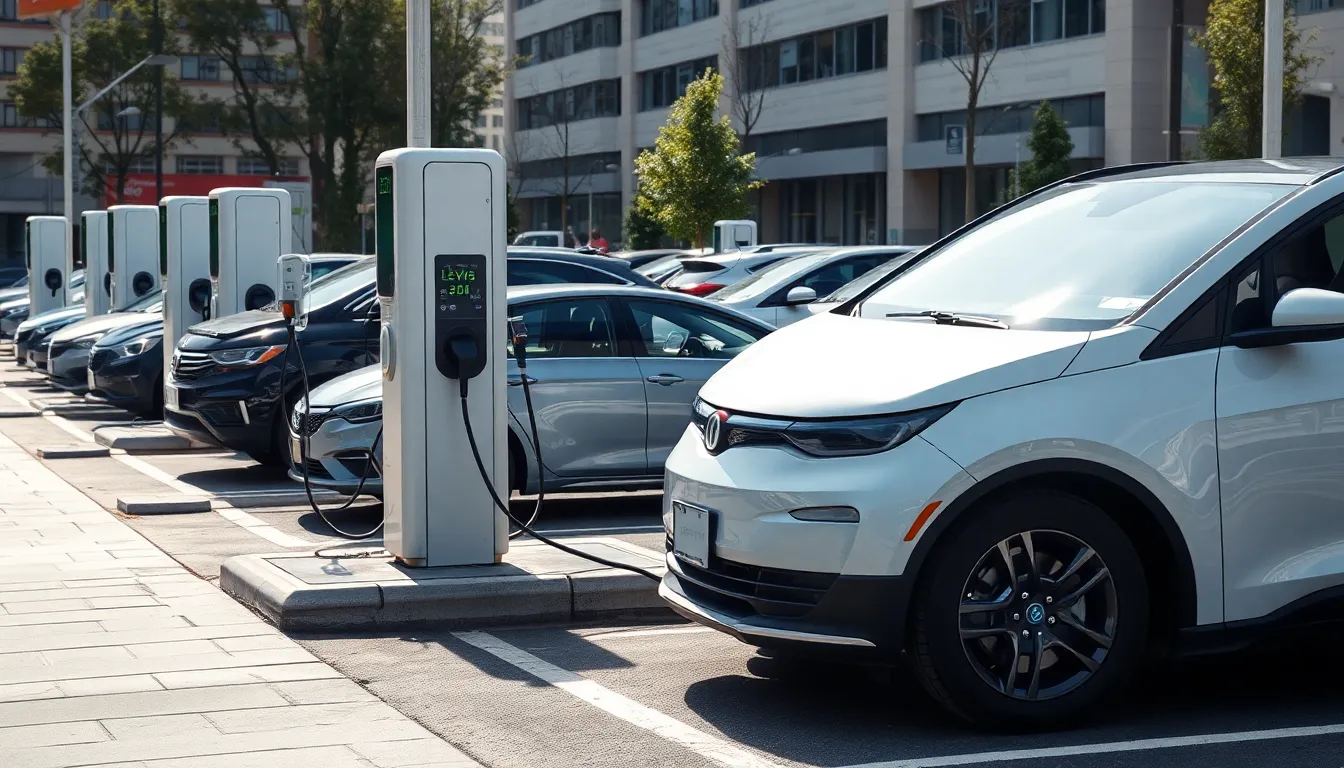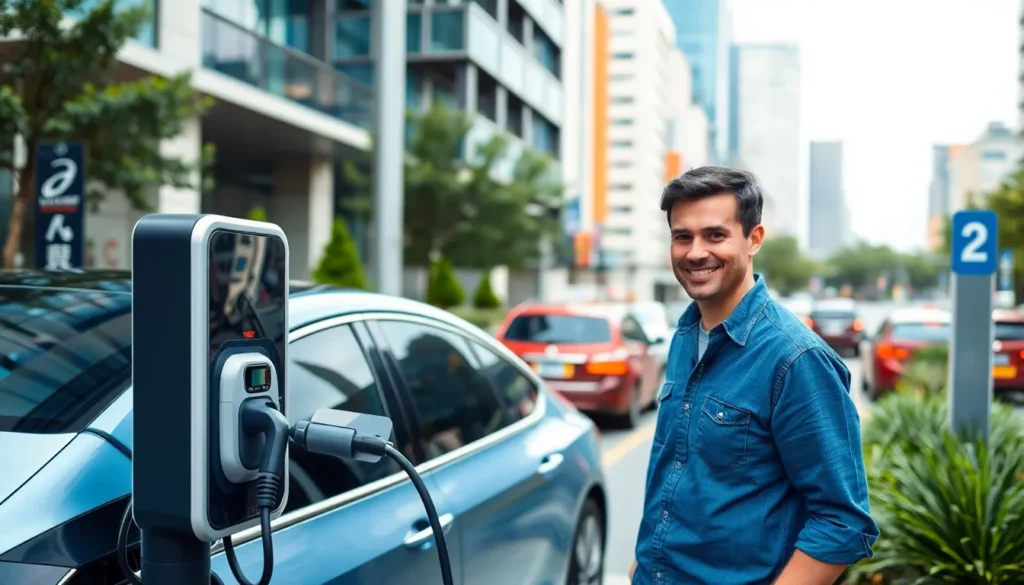As electric vehicles (EVs) surge in popularity, the demand for accessible and efficient charging points has never been greater. With a growing number of drivers making the switch to electric, understanding the landscape of EV charging infrastructure becomes essential. These charging points not only support the transition to greener transportation but also play a crucial role in shaping the future of urban mobility.
Navigating the world of EV charging can be overwhelming, especially with various types of chargers and networks available. From home installations to public charging stations, each option presents unique benefits and challenges. This article delves into the different types of EV charging points, their locations, and how they contribute to a sustainable future, ensuring that drivers can make informed choices on their electric journey.
Table of Contents
ToggleOverview of EV Charging Points
EV charging points serve as critical infrastructure for electric vehicles, facilitating convenient and efficient recharging. As the number of electric vehicles increases, understanding the types and importance of these charging points becomes essential.
What Are EV Charging Points?
EV charging points are stations that provide electric energy to recharge electric vehicles. They come in various forms, including:
- Level 1 Chargers: Standard household outlets, offering about 2 to 5 miles of range per hour.
- Level 2 Chargers: Commercially available units, providing around 10 to 60 miles of range per hour, suitable for public and home installations.
- DC Fast Chargers: High-powered stations, delivering 60 to 350 kilowatts, allowing for rapid charging in 30 minutes or less.
Charge points are often found at homes, workplaces, and public areas, making recharging accessible and convenient for EV owners.
Importance of EV Charging Points
EV charging points play a vital role in the transition to electric mobility. Their significance includes:
- Supporting EV Adoption: A robust network of charging stations encourages drivers to switch to electric vehicles, addressing range anxiety.
- Enhancing Urban Infrastructure: Strategically placed charging points contribute to the development of smart cities, integrating sustainable energy solutions.
- Reducing Emissions: Expanded charging infrastructure promotes the use of electric vehicles, contributing to lower greenhouse gas emissions.
- Facilitating Renewable Energy Use: Charging stations can be interconnected with renewable energy sources, optimizing the usage of clean energy for vehicle charging.
Establishing comprehensive EV charging infrastructure fosters the growth of electric vehicles and supports environmental goals.
Types of EV Charging Points

Understanding the different types of EV charging points is essential for maximizing charging efficiency and convenience. The primary types include Level 1 Charging, Level 2 Charging, and DC Fast Charging, each serving distinct needs.
Level 1 Charging
Level 1 Charging uses standard household outlets to recharge electric vehicles. Typically, it provides 120 volts and delivers around 4 to 5 miles of range per hour of charging. This type is often utilized in residential settings, where convenience outweighs speed. Many EV owners use Level 1 chargers overnight, with minimal investment in infrastructure. This option is most suitable for those with low daily driving needs and access to a home electrical outlet.
Level 2 Charging
Level 2 Charging units operate at 240 volts, offering significantly faster charging capabilities than Level 1 options. They provide 10 to 60 miles of range per hour of charging, making them ideal for public charging stations and residential setups. Level 2 chargers are widely available at commercial locations such as shopping centers, workplaces, and parking garages. Many EV owners install Level 2 chargers at home to expedite daily charging routines. This type effectively accommodates the fast-paced lifestyles of urban drivers who rely on electric vehicles for extended commutes.
DC Fast Charging
DC Fast Charging stations deliver rapid charging by supplying direct current (DC) at high voltage. They typically provide 100 to 350 kW of power, enabling an EV to gain 60 to 100 miles of range within 20 to 30 minutes of charging. These stations are commonly found along highways and in busy urban areas, strategically placed to support long-distance travel. DC Fast Charging represents a crucial infrastructure for EV adoption, offering the speed necessary to make electric vehicle ownership practical for a broader audience.
Locations of EV Charging Points
Accessible EV charging points are essential for supporting electric vehicle (EV) usage across various environments. Their distribution includes public areas, residential neighborhoods, and workplaces to ensure convenience for all drivers.
Public Charging Stations
Public charging stations are widely available in urban areas, shopping centers, and along major highways. These stations typically offer Level 2 and DC Fast Chargers, catering to different user needs. Level 2 chargers facilitate longer stops, such as during shopping or dining, while DC Fast Chargers allow for quick recharges during road trips. According to the U.S. Department of Energy, over 100,000 public charging points exist in the United States, with growth expected as EV adoption increases.
Home Charging Solutions
Home charging solutions provide a convenient option for EV owners. Level 1 Chargers can utilize standard household outlets, making them easy to install and perfect for overnight charging. Level 2 Chargers, requiring a dedicated 240-volt circuit, are popular for homeowners wanting faster charging capabilities. Surveys indicate that about 80% of EV charging occurs at home, emphasizing the importance of residential infrastructure in supporting EV owners.
Workplace Charging Options
Workplace charging options enhance employee satisfaction and support sustainable commuting. Numerous employers install charging stations in parking facilities, offering Level 2 and DC Fast Chargers. These installations promote the use of electric vehicles and can attract environmentally conscious talent. Research shows that workplaces with charging stations see a substantial increase in EV adoption among their employees, making these solutions beneficial for both businesses and the environment.
Benefits of EV Charging Points
EV charging points bring significant advantages that support the widespread adoption of electric vehicles. Their environmental benefits, cost savings, and convenience enhance the overall appeal of transitioning to electric mobility.
Environmental Impact
EV charging points play a crucial role in reducing greenhouse gas emissions. Electric vehicles, when charged with renewable energy sources, contribute to a substantial decrease in air pollutants, improving urban air quality. According to the U.S. Environmental Protection Agency (EPA), electric vehicles lead to approximately 50% lower emissions compared to their gasoline counterparts over their lifetimes. Additionally, charging infrastructure supports the integration of more renewable energy into the grid, promoting sustainable energy practices.
Cost Savings
Using EV charging points can lead to substantial cost savings for drivers. Electric vehicles typically incur lower fueling costs than traditional gasoline vehicles, with a difference of about $1.00 to $2.00 per gallon equivalent of electricity. Incentives, tax credits, and rebates for installing home charging stations further enhance these savings. Additionally, some public charging stations offer lower rates during off-peak hours, allowing for additional savings on charging expenses.
Convenience
EV charging points provide unmatched convenience for electric vehicle owners. Home charging options offer the ability to recharge overnight, ensuring the vehicle is ready each morning. Public charging stations, strategically located in urban centers and along highways, cater to drivers’ needs during trips. A network of Level 2 and DC Fast Chargers reduces range anxiety, allowing for smooth and efficient long-distance travel. Access to charging stations enhances the overall experience of owning an electric vehicle, encouraging more drivers to make the switch.
Challenges Facing EV Charging Points
Electric vehicle (EV) charging points encounter multiple challenges that hinder their widespread adoption. Addressing these issues is crucial to enhance the efficiency and accessibility of charging infrastructure.
Infrastructure Limitations
Infrastructure limitations pose significant barriers to the expansion of EV charging points. Many regions lack sufficient charging station coverage, particularly in rural areas. Data indicates that about 39% of Americans reside in locations with inadequate charging access. Existing electrical grids struggle to support a rapid increase in EV charging demand, leading to potential strain during peak usage hours. Upgrading and expanding grid capacity, while costly and time-consuming, remains essential for accommodating future growth in electric vehicles. Studies suggest investments of $20 billion annually in charging networks are needed to meet demand projections by 2030.
Accessibility Issues
Accessibility issues create additional obstacles for EV drivers. Not all charging stations offer the same usability features. For example, some stations may have incompatible connectors or lack user-friendly interfaces. Furthermore, charging stations often experience downtime due to maintenance or technical issues, reducing their availability. Ongoing reports identify that around 15% of public charging stations are out of service at any time. Additionally, the placement of charging points frequently does not consider users with disabilities or those in locations with limited parking. Ensuring fair accessibility across different communities, particularly in low-income areas, remains critical for increasing EV adoption.
Future Trends in EV Charging Points
Innovations and network expansions are shaping the future of EV charging points. These trends enhance the accessibility and efficiency of electric vehicle charging, facilitating broader EV adoption.
Technological Innovations
Technological advancements drive the evolution of EV charging points, introducing faster and more efficient charging solutions. Wireless charging technology eliminates the need for physical connections, offering convenience and ease of use. Smart charging systems use AI to optimize energy consumption based on demand and grid conditions, ensuring that charging occurs during off-peak hours. Moreover, ultra-fast chargers, which can deliver up to 350 kW, reduce charging times further, allowing EVs to recharge in less than 10 minutes for significant mileage. Vehicle-to-grid (V2G) technology also emerges, enabling EVs to return excess energy to the grid or supply power during peak periods, enhancing grid stability.
Expansion of Charging Networks
Expansion of charging networks is critical for addressing the growing demand for EV charging infrastructure. Governments and private companies invest in building extensive charging networks to ensure widespread coverage. Current data suggests that the number of public charging stations in the U.S. increased by 25% in 2022 alone, with continued growth projected. Strategic placements focus on urban areas, highways, and remote locations to minimize range anxiety. Partnerships between charging network providers and businesses aim to integrate charging points in retail spaces, enhancing access for consumers. Additionally, initiatives targeting workplace charging installation promote sustainable commuting and encourage EV adoption among employees, thereby expanding the charging network effectively.
The rise of electric vehicles brings with it an urgent need for a robust charging infrastructure. As the demand for EV charging points grows, addressing accessibility and efficiency becomes paramount. Innovations in technology and strategic investments in charging networks will play a crucial role in shaping the future of urban mobility.
By enhancing the availability of charging stations in key locations, stakeholders can alleviate range anxiety and promote wider EV adoption. The transition to electric vehicles not only supports environmental goals but also offers cost savings and convenience for drivers. As the infrastructure evolves, it’s essential to ensure that all communities benefit from this green revolution, paving the way for a sustainable future.




